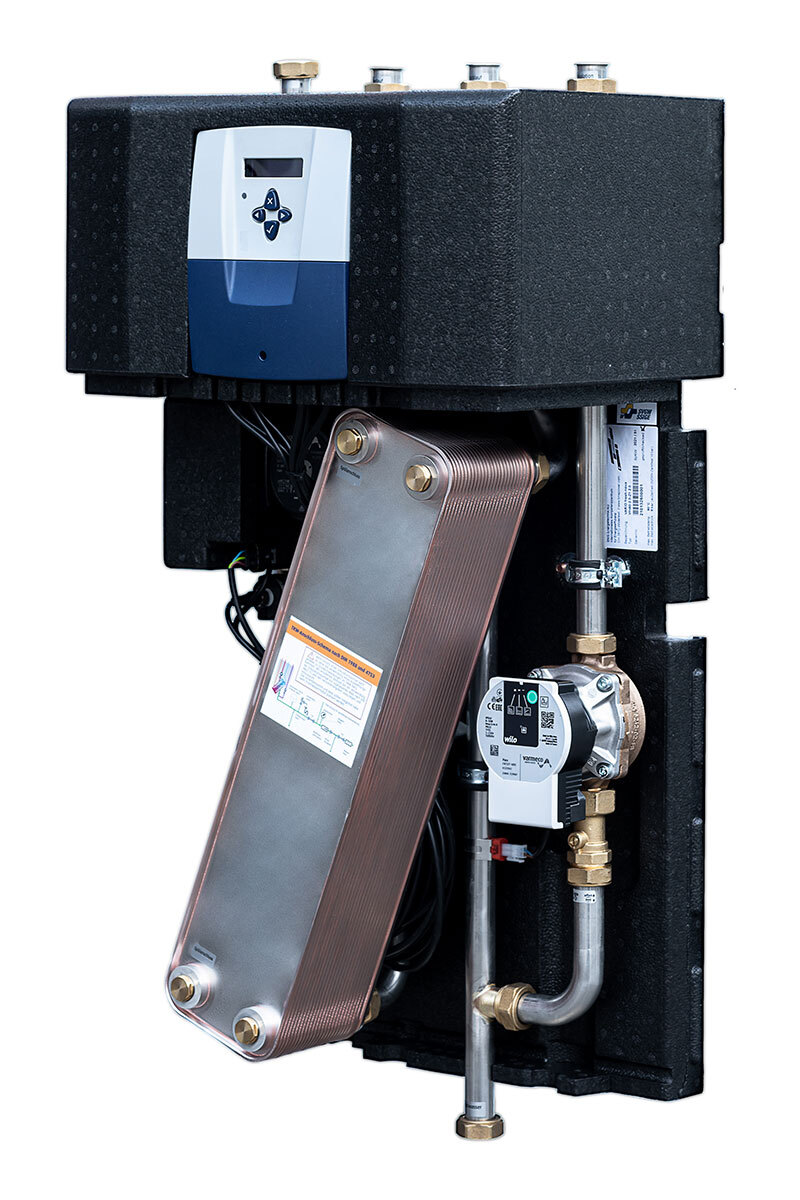Do you have any questions about this product?
Then I'm happy to help.


Whether in residential buildings or hospitals: in both small and large properties, drinking water hygiene – and thus the prevention of Legionella bacteria – plays an important role. BMS's fresh water technology offers this hygiene! It uses so-called fresh water stations to heat fresh, cool drinking water on a continuous flow basis. Warm water is therefore not stored, but only heated when it is needed.
This has two key advantages:
Any form of stagnation – such as in a domestic hot water tank – would promote the growth of Legionella bacteria. With fresh water technology, however, the hot water is usually in flow and does not give Legionella bacteria any chance to multiply. A reliable, hygienic principle that can provide small and large quantities.
Where immediate availability of hot water is desired or required by technical regulations, our exergy-optimised fresh water station cascades are the ideal solution. They ensure that the hot water circulating in the building is always kept at a sufficiently high temperature to effectively prevent the proliferation of Legionella bacteria in the pipe system. At the same time, the cascade ensures low heating return temperatures when tapping drinking water. This system therefore takes both comfort and energy efficiency into account.
Whether in residential buildings, commercial premises or sports facilities – we offer fresh water technology solutions for all types of properties, making showering, washing and cooking more hygienic and comfortable. Our controllers ensure this with demand-based and energy-efficient heat input.
If little hot water is drawn, only a small amount of heat is used. If a lot of hot water is required, the control increases the heat output and can thus cope with even large flow rates. This means that the hot water always reaches the tap at the same temperature – not too hot, not too cold. This makes showering, for example, a pleasant experience.


Hygienic heat transfer
The core component of a fresh water station is a stainless steel heat exchanger through which drinking water flows on one side and heating water on the other. The heat exchanger thus ensures strict separation of drinking water and heating water. The fresh water station draws the heating water for heating the drinking water from a heating buffer tank. When hot water is requested at a tap (e.g. shower or washbasin), a pump transports heating water from the buffer tank to the heat exchanger in the fresh water station, where the heat energy is transferred to the fresh drinking water.
Integrated control
Depending on the amount of hot water drawn, a corresponding amount of heat is taken from the heating buffer tank. The amount of energy is regulated by an adjustable feed pump. If little hot water is required, the pump supplies a small amount of heating water; if demand is high, it increases the speed and thus the amount of heating water used to heat the drinking water. The fresh water station also contains a controller with a neural network. This continuously processes information about consumption behaviour and adjusts the control system to the preferred operating conditions.
Resource-saving hot water circulation
In hot water systems with circulation, the control of the circulation pump ensures the optimum compromise between comfort, hygiene and energy efficiency: if a target temperature is exceeded at the temperature sensor of the circulation return pipe, the pump switches off. This saves heating energy for circulation operation, minimises heat loss and reduces the pump's power consumption.
Regardless of which system is used for heating drinking water, the following rules apply, among others:
A fresh water station as a subcomponent of the overall system for domestic hot water treatment cannot, of course, prevent the proliferation of Legionella bacteria in an overall system on its own. However, in terms of system technology, it is the most favourable prerequisite for this. This is because the proliferation of Legionella bacteria is prevented by, among other things:
It should also be noted that the installations must be carried out in accordance with the latest state of the art (unused pipes should be avoided). Compared to conventional boiler systems (i.e. with a drinking water storage tank), fresh water stations do not have stagnant volumes with poor flow and therefore poor heating. Large deposits, which are ideal breeding grounds for bacteria, do not occur in fresh water stations either. Legionella circuits and disinfection circuits are also possible at any time for the pipe system with fresh water stations.
As no complicated and sensitive control systems are used, the fresh water stations function without any complex maintenance measures once they have been correctly commissioned.
If, as the operator, you want regular maintenance of the fresh water stations, the settings are checked in accordance with the commissioning protocol and a functional check is carried out.
As a general rule, a fresh water station is also a technical device whose service life can be extended by sporadic or regular inspections.
Various measures are taken to prevent calcification of the plate heat exchangers in the fresh water stations:
Unlike conventional boiler systems, fresh water stations can be oversized because only the amount of hot water currently required is treated.
Thanks to their modular design, fresh water stations can also be expanded relatively easily at a later date (higher peak outputs).
Depending on temperatures and outputs, between one and four devices can be used, interconnected as a cascade. In the case of cascades, only one station operates when demand is low, with others switching on as demand increases. Cascading ensures high control quality even in the lower partial load range and guarantees high availability. Pressure loss across the entire system can thus be kept very low and temperature fluctuations at the taps can be avoided.
The required output is defined by the transfer capacity of the plate heat exchanger in the fresh water station, the size of the buffer storage tank and the recharging capacity.
A precise calculation taking into account guidelines and regulations such as SIA385/1: 2011, DIN 4708, DIN 1988 and "Sanitary calculations – short and sweet" (Suissetec), the use of calculation programmes and, last but not least, a wealth of experience ensure that the required peak performance is maintained. This means that peak volume flows of, for example, over 400 litres per minute are possible at corresponding temperatures.
The control system guarantees that the outlet temperature does not exceed the set maximum value of 60°C, even if high temperatures prevail in the energy storage system (solar systems).
The temperature control quality is certainly dependent on the manufacturer. The quality of the BMS system has been tested by an independent body (SPF Rapperswil) and documented as high quality. The associated control technology has also been tried and tested in practice for many years.
In good fresh water stations, the drinking water temperature is set between 35 and 60°C. It can be set to the desired level. In addition to the usual 60°C, it can also be temporarily increased to over 70°C for thermal disinfection without much effort.
The fresh water stations have an autonomous control system that only needs to be supplied with 230V power. All control and regulation elements are already compactly installed, wired and tested.
Yes. However, as everywhere else, it is important to consider the overall system! After all, a domestic hot water heating system is only as good as its integration into the overall system.
Do you have any questions about this product?
Then I'm happy to help.

Do you have any questions about this product?
Then I'm happy to help.

Do you have any questions about this product?
Then I'm happy to help.
